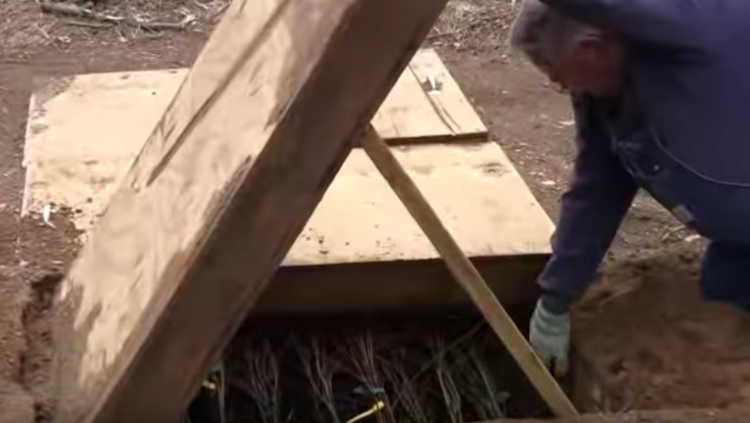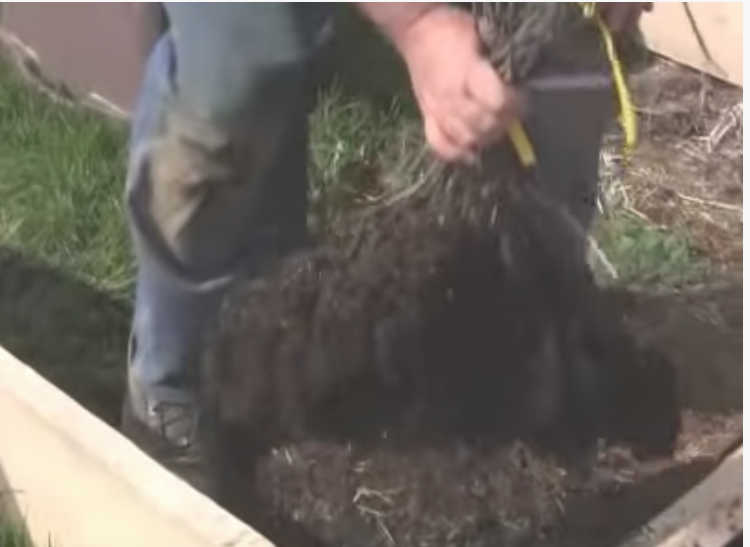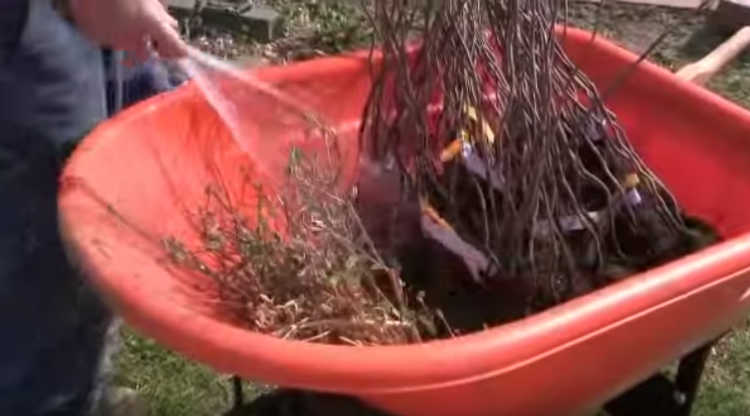
Why would you need an underground root cellar? An underground root cellar can provide you a place to store plants, or plant bulbs, anything that you want to protect from freezing. I build mine to store rare Japanese maples that I’d get shipped in during the winter months but couldn’t plant out until spring.
One of the perks of Our Members Area is having the ability to buy things like really rare, really beautiful Japanese maple varieties for prices that might range from $8 or $10 each up to about $20 each. And if you’ve priced Japanese maples in a garden center, you know those are crazy low prices!

As you can see in some of the photos and the video on this page I put hundreds of Japanese maples, redbud trees and dogwood trees in my underground root cellar.
My underground root cellar was 42″ wide, 8′ long and about 24 to 30″ deep. I’m pretty sure the sides were only 24″ but the lids were about 5″ thick. In my root cellar my plants never froze and I’m in northern Ohio! It gets cold here!
The rest of this article will explain why this works so well.

You probably don’t have to be 42″ but that’s not a bad thing. My cover was two by four frames with 3/4″ treated plywood on both sides. My cover was actually three pieces. Heavy, but well insulated, no insulation needed, the air space is plenty. I really need to do a blog post on water meters and ground heat because it is very educational.
Around here most of our water meters are in the ground, vaults about 24″ wide and 36″ deep. The actual water meters are on risers so the top of the meter might be as close as 12″ to the top of the vault. They never freeze. The only time they freeze is if they are located in a driveway, sidewalk, or the vault is not installed deep enough.
Important points.
1. The vaults have a cast iron lid that can translocate cold if the vault is installed so the lid sticks up above the grass in the lawn.
2. If the vault is installed properly the lid is about one to two inches below grade, usually one inch is plenty.
3. The ground heat from the vault will warm that cast iron lid enough to melt snow that lays on top of the cast iron lid. Let that sink in. Let’s say the air temp is 20 degrees F. outside, the ground heat in the vault can make that cast iron lid warm enough to melt snow.
4. Since snow is a good insulator, it actually helps to keep that cast iron lid warm enough to melt snow with help from the ground heat inside the vault. Snow cover actually makes it warmer in the vault.
5. This is so evident that as a meter reader you can walk down a snow covered sidewalk and you see a dimple in the snow covered tree lawn and sure enough, that’s exactly where the water meter is. It never fails. The heat from inside the vault, through a cast iron steel lid will melt the snow enough to make the snow sink over the vault lid and it makes the location of the water meter obvious as you walk along.
6. What messes that up? What would keep the snow from melting on top of that cast iron vault lid? Leaves. Just a very thin layer of leaves, probably about 1/8″ is enough to insulate the vault lid and the snow does not melt making the vault lid invisible in that snow covered tree lawn.
7. 1/8 of an inch of leaves act as an insulator. So a 5″ thick cover made of wood, not steel is super insulator!
8. Here’s another thought. Why do leaves collect on the vault lid? Because it’s recessed just enough that once the leaves settle on the vault lid the wind blows over top of them and cannot pick them up and blow them away. Think about that.
9. That’s why in the event of a tornado a ditch is an option to stay out of the wind.
So I am suggesting at least 30″ deep, at least 8′ long and about 44″ wide. Think bigger.
Since those wooden covers can be quite heavy consider setting up a pulley system to lift the lid when you need to.
Another, must simpler thing that I’ve done to store bare root trees until spring is to build a frame on top of the ground and simple heel in the plants with a potting mix. I don’t consider this the ideal method but it’s work well for me when I’ve done it.



Looks very interesting. I have wanted a root cellar for many years. Though I am sure in my area it would need to be much deeper and would need more insulation as well as some type of structure with a door. I’m in a small rural village in Alaska where -25 is not unusual for weeks or more at a time and where I have seen -30 in March.
Vickey,
The answer to that lies in “how deep do they bury water lines in Alaska? Here in Ohio it’s 48”.
Mike, we had a large masonry root cellar in Northern Ohio that resembled a half buried cabin. The floor was 4 feet below grade. My parents kept vegetables in there over winter covered in straw. Your point about water meters never freezing at modest depth tells me straw wasn’t needed. Regarding ground heat, I’m surprised how warm the water from my 300 foot deep well is even on a freezing day. Ground heat is free and collector pipes don’t need to be very deep to be effective. Geothermal heating should get more popular where it gets REALLY cold like the northern Buckeye. Remembering our drafty old farm house, the root cellar would have been easier to heat in the cold months.
George,
I’m always amazed at ground heat, even close to the surface. Recently I built a small platform just 6″ off the ground. The snow and ice stay on that thing for days while the snow on the ground is long gone. But just that little bit of air under that platform keeps it frozen.
What about burying a plastic truck toolbox. It has a lid. It’s about 4 ft x 20 in wide and 20 in deep.
Do you think this would work as a root cellar?
Robert, I’m sure it would to a degree, especially if you cover the top of it with straw or something. It’s amazing how much something like straw insulates things.
Wish I lived closer to you to be able to be in all these activities. Love your family AND the Donkeys@@
Me too Cleo!
I have a historic home (1895 Queen Anne Victorian). The back of the house gets tons of sun early morning through evening, with about a two hour break early afternoon. My question is this. Because there are stone walls and block stairs leading down to the back door of the basement, I’ve considered covering the entire top area at the ground level with some boards so I can overwinter plants. In the heat of summer, if I walk down those steps where the coal used to be delivered before furnances were installed, the temperature drops a good 15 to 20 degrees. (I go there to cool off sometimes while doing spring and summer gardening!) The length is about 20 feet from the edge of my two veggie gardens to the house. The width is about 7 feet from edge to edge of the stairway blocks. I think I should use more about three boards so they are not too heavy for me (a 100 pound woman) to lift individually so I can check on plants and put more on the steps going down to the basement.. I’ve had the door boarded on the inside of the basement after someone broke in one day years ago while I was gone. The 15 pound miniature schnauzer met the intruder at the top of the stairs leading into the house’s ground floor when he broke the door to the kitchen in. Yup. The dog won. Schnauzers are extremely territorial, loyal and protective of their home base! I’m sure the intruder wanted some of my rare house plants?
Do you think I could do this project? I don’t want the plants to get too hot over winter. Right now, we’ve been having 50 to 70 degree days in January when normal highs are 30 to 40. So a layer of leaves over the boards would keep things cool plus add protection against cold snaps? It was 19 the other night after weeks of lows in the 50s. Odd weather for sure!
Many thanks for any advice. I grew up in Northern Illinois, but here in East Tennessee gardening is much tougher. I miss that great black dirt. Tennessee has so much clay.
Jayne,
I think your plan is reasonable, we have a member, http://backyardgrowers.com/join, who uses his basement stair well to hold perennials grown from seed til spring. To harden them off really.
Hi Mike,
Good article as usual. We do it a little differently. We make cold frames sunk into the ground about 6 inches then cover with a discarded sliding glass door. We can store beets and turnups under mulch and eat the greens as well.
Great idea Chuck, thank you for sharing.
Thanks, Mike! This is so exciting! I’ve wanted a root cellar for so long but never thought I could have one on my property. It looks like I might get one after all. 🙂
Glad I’m able to help!
Gosh. Our school garden has been following you for at least 8 years. We are now getting our first hoop house 36ft X 20 ft installed here in Ga. Any advice?
Terri,
Around here most hoop houses are used for over wintering and the plastic is removed in the spring. In Georgia you really have to be concerned about heat in the hoop house in the summer. You might find it more useful for winter projects. Not sure what you intend to use it for.
Mike
I have a hoop house that I cover in winter but I remove the plastic and cover with shade cloth from about May til October. Keeps the plants out of the blazing sun and reduces the need for a lot of watering.
Ann
Great Information Mike. I’m tackling this project in 2020.